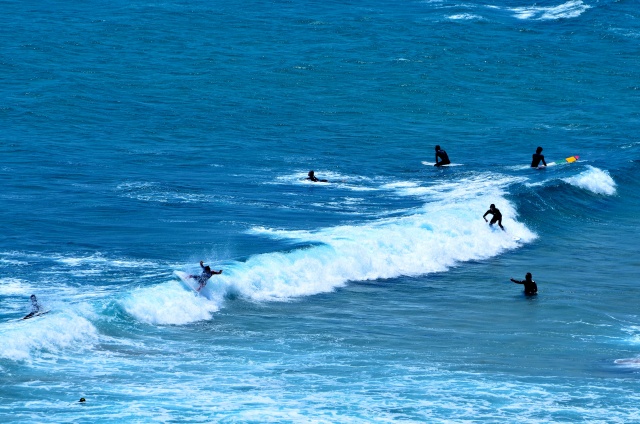| |
 |
|
| ▲ Hyeopjae Beach |
Beaches in Jeju are set to fully open in July 1. Jeju has 12 designated beaches, consisting of eight in Jeju-si (Geum Neung Beach, Hyeopjae Beach, Gwakji Beach, Iho Tewoo Beach, Samyang Beach, Hamdeok Beach, Gimnyeong Beach, Woljeong Beach) and four in Seogwipo-si (Hwasun Golden Sand Beach, Jungmun Saekdal Beach, Pyoseon Beach, Shinyang Seopjikoji Beach).
Each of Jeju’s beaches has a unique aspect and offers an ideal location for enjoying the beautiful scenery and playing in the water. Most accommodations in Jeju are situated within a 30-minute distance from a beach regardless of the region, making Jeju one of the most popular destinations for summertime vacations.
| |
 |
|
| ▲ Children cool-off in the water fountains at Gwakji Beach - Photo by Jeju Tourism Organization |
Jeju’s beaches are perfect for couples, families and friends alike, but there are times when visitors might have a less than perfect experience without knowing some essential information.
Some of Jeju’s sandy beaches can sometimes be covered in green vegetation, consisting of types of seaweed named ulva pertusa and sargassum horneri.
Visitors may be hesitant to go into the water if the beach is covered in seaweed, due to their unsavory odor and squishy texture when walking on top of them, while children may also be afraid of seaweed.
Although the provincial government and individual towns regularly remove such seaweed, the tide constantly brings in new swathes of seaweed. The seaweed removal efforts have been taking place since 1999, but it is impossible to keep the beaches completely free of seaweed.
Designated beaches hire employees to remove the seaweed each day, which makes the situation a little better, but non-designated beaches cannot do the same due to the lack of manpower. Those wishing to play in the water at the beach with their children are recommended to check for seaweed before doing so.
| |
 |
|
| ▲ Photo by Jeju Tourism Organization |
Jeju’s beaches are also popular surfing spots where many surfers gather. Locations such as Jungmun Saekdal Beach in Seogwipo and Woljeong Beach in Jeju-si also offer surfing lessons, allowing visitors to enjoy surfing the waves for sessions of three or four hours.
Surfing at Jeju beaches is not as simple as bringing a surfboard, since each beach has a designated surfing area. However, the surfing areas are becoming crowded due to the growing number of surfers and surfing lessons, thereby leading to occasional collisions.
Surfboards are mostly made of polystyrene and therefore safe in such situations. Nonetheless, beginners may lose control of their surfboards, which may be swept away by the waves and strike people in the vicinity, causing injuries that may be fatal in cases where a board strikes a person’s face.
Furthermore, those swimming in the water must exercise caution as they may unknowingly drift into the surfing area and accidentally be hit by a surfboard from behind.
On May 26, a highly venomous species of jellyfish was sighted off the coast of Jeju (Cha Guido Island, Jeju Harbor) and is expected to be found at beaches across Jeju.
In 2019, a large number of Nemopilema nomurai jellyfish were found in Jeju, leading to the announcement of a jellyfish warning across all beaches.
When stung by a jellyfish, you must immediately leave the water and thoroughly wash the affected area using seawater or physiological saline. Tap water cannot be used since it may exacerbate symptoms. If symptoms such as breathing difficulties and full-body pain occur after a jellyfish sting, you must go to the nearest hospital at once.
If a jellyfish is sighted at sea, you must report it to the jellyfish reporting webpage (www.nifs.go.kr/m_jelly), the National Institute of Fisheries Science (051-720-2223, 2233), or the coast guard.
Although entry at Jeju beaches last year required a body temperature check, entry/exit logs, and face masks, visitors may go in the water without wearing a mask this year. However, it is recommended to keep a 1m distance with other people, even in the water, while a mask must be worn when lining up for showers and changing rooms.
Despite the easing of COVID-19 quarantine measures such as the withdrawal of mask mandates, visitors may only enter the water between 10am and 7pm, with nighttime swimming prohibited entirely.
Jeju’s designated beaches are guarded by 330 civilian safety officers, including 119 emergency response teams, firefighters, and administrative employees, as well as 15 rescue boats and 7 motorboats. However, only 58 safety management officers are stationed across the 17 non-designated beaches, and therefore it is recommended for visitors to bring their own safety equipment such as life jackets. |























